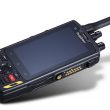PRODUCT BRIEFS
Kenwood intros mobile and portable radios
Kenwood Communications recently introduced the TK-7180/8180 UHF/VHF mobile radios, which are targeted for public safety and business fleets. The radios offer 30 watts of power in both UHF and VHF models, 512 channels, 128 zones and a redesigned chassis that features a 12-character dot matrix display and front-facing speaker. The radios also offer a voice storage capability and have a built-in voice inversion scrambler for increased security, the company said. In addition, Kenwood announced the introduction of the TK-2200/3200 portable radios, which are targeted to manufacturing, industrial, construction, warehouse, retail and hospitality sectors. The radios offer a “SuperLock” function that disables all but the push-to-talk and volume settings to prevent accidental channel changes, and a Calling Alert function, designed for high-noise environments, that produces a high-decibel tone when a transmission occurs.
www.kenwood.net
Maxrad adds sector panel antennas
Maxrad recently introduced a line of directional sector panel antennas designed for wireless Internet point-of-presence network sites that operate in both the Wi-Fi and WiMAX unlicensed bands. The MSB2401690 utilizes pattern-shaping technology to allow contoured coverage and optimal signal performance within the desired propagation area. It covers frequencies from 2.4 GHz to 2.5 GHz with 16 dBi gain and front-to-back ratio greater than 28 dB. The WiSP24017MBH is a 2.4 GHz horizontally polarized antenna that offers selectable horizontal beam-width options of 45, 60, 90 and 120 degrees, and up to 17 dBi gain in a compact UV-resistant housing. It has a front-to-back ratio greater than 30 dB at 120, 90 and 60 degrees, and greater than 26 dB at 45 degrees. In addition, Maxrad has added two antennas that cover the 2700 MHz to 2900 MHz frequencies, and said it would introduce a wideband adjustable sector panel antenna covering 4.9 GHz to 6 GHz in mid-September.
www.maxrad.com
EFJohnson plans Netelligent upgrade
EFJohnson said it is developing the next version of its Netelligent Project 25-compatible, IP-based infrastructure systems. The next phase will incorporate more options for dispatch consoles, according to marketing communications manager Kevin Nolan, who added that the company is gearing up for the launch at its Irving, Texas, facility. “We’re going to go from about 40 employees to about 110 by the end of the year, and a lot of them are going to be engineers,” he said.
www.efjohnson.com
M/A-COM adds messaging to OpenSky
M/A-COM announced during APCO that it has added Text Link, a text-messaging application, to its OpenSky network. The company said the service is similar to the short message service offered by commercial wireless carriers, and would enable first responders to share real-time intelligence and communications during incidents. In addition, the company said it would upgrade its M7100IP and P7100IP P25 portable and mobile radios by adding AES encryption. The radios already feature DES OFB encryption. Finally, M/A-COM announced that a recent series of customer tests indicated its P7100IP radios are compatible with other commercially available P25 radios — including those manufactured by Motorola, Thales, Datron and RELM — in three broadcast modes: P25 conventional common air interface (CAI) unencrypted, P25 CAI with DES encryption and P25 CAI with AES encryption.
www.macom.com
Tait adds high-power mobile radio
Tait Mobile Radio debuted the TM 8200 mobile radio, a dual-mode conventional/MPT trunked radio that provides 1500 conventional channels, four MPT networks and an optional internal data modem that offers throughputs up to 19 kb/s. A 25-watt version is available currently, with a 40-50 watt model scheduled for availability “shortly after Christmas,” according to Martin Ball, product group planning manager. The introduction of the 40-50 watt version represents a “significant milestone” for Tait, Ball said. “It will be the first time we had a high-powered radio in the U.S. market,” he said. “It’s what the U.S. market demands.” Tait also demonstrated its Project 25-compliant systems during APCO in Montreal last month. The company plans to introduce base stations in the first quarter of 2005 and subscriber units in the second quarter. Beta testing is scheduled for sometime around Christmas. Like EADS North America, which announced during APCO it was joining the P25 fray (page 49), Tait is undeterred by the fact it is a latecomer, according to Ball. “We’re getting strong encouragement from customers who tell us they need more players.” Ball added that Tait’s strength in infrastructure would ease the transition into the P25 market. “One of our strengths has been our backbone, and customers are confident in us. Other players, such as those in Asia, are focused more on subscriber units,” he said. “This will be a very natural migration for us.”
www.taitworld.com
Cisco brings conferencing to public safety
Cisco Systems introduced its MeetingPlace solution to the public-safety sector during APCO. Originally developed for the enterprise market, MeetingPlace is a voice and Web conferencing solution that can be integrated with private voice and data systems. With MeetingPlace, users can create virtual conferences that enable the participants to communicate with each other regardless of the devise used, including two-way radios and cellular phones, according to Glenn Inn, product development manager. Voice and data, including video, is transmitted via wireless Internet Protocol. “The people who have to make key decisions at an incident will be able to make more effective decisions in a shorter amount of time, because they can really see what’s going on,” Inn said.
www.cisco.com
Thales upgrades radio volume of P25 radio
Thales Communications has increased the audio volume of its Thales P25 radio via a software upgrade. “Customers were having issues hearing their radios when they were on their belts,” said Bob DiDonato, field services engineer. “They’re excited about this because they’ve wanted it for a long time, and they’ll be able to do it without having to send their radios in.”
www.thalescomminc.com
Motorola intros data solution for agencies
Motorola announced during last month’s Association of Public-Safety Communications Officials conference in Montreal that its Windows-based Digital Justice Solution Select (DJSS) would provide mid-sized public-safety agencies with “many of the same functional benefits” as those enjoyed by large agencies. The solution is designed to provide “fast and economical” deployment of computer-aided dispatch, records management and mobile data computing systems, the company said. Because the solution is Windows-based, standard, pre-configured options can be combined with a mission-critical configuration to meet the budget requirements of individual agencies, the company said. It is expected to be available “later this year,” according to Motorola. In addition, Motorola announced a softswitch designed to provide interoperable communications between public-safety agencies using disparate radio systems and a mobile automated fingerprinting system that provides law enforcement personnel with remote access to fingerprints, facial images and criminal history records in real time at an incident scene. The Soft Switch Radio Network is expandable, with capacity for more than 10,000 talk paths, is Internet Protocol-based and offers distributed control points, eliminating single points of failure. The Mobile Automated Fingerprint Identification System is based on the company’s fingerprint solution that is used by law enforcement agencies in 37 countries. In addition to providing access to a department’s own databases, it also provides access to the National Crime Information Center and state departments of motor vehicles.
www.motorola.com
RELM adds encryption to P25 radios
RELM Wireless said it has added AES and DES encryption to its BK Radio DPH digital portable radio. The company said the enhancement brings the radios into compliance with APCO’s Project 25 standard, including encryption. In addition, RELM announced that the frequency range for its DPH digital portable radio has been expanded to 136-174 MHz from the previous range of 147-174 MHz, in turn expanding the potential market for the radios.
www.relmwireless.com
Padcom to upgrade TotalRoam
Padcom said it would release version 4.1 of its TotalRoam mobile data solution in October. According to Mark Ferguson, marketing director, the upgrade will introduce an SNMP function that will enable system administrators to remotely configure changes to the system. Also, a radius authentication capability will be introduced. “These upgrades will give users greater flexibility,” Ferguson said. Padcom also plans to upgrade its TR6100 mobile router “later this year,” Ferguson said. Additional Ethernet ports will be added, and the router will become field upgradeable. “Users will be able to upgrade simply by popping in PC cards, much like how you do on a computer,” Ferguson said.
www.padcomUSA.com
Survey Technologies adds bit-error rate testing
Survey Technologies said during APCO it has developed a product that enables law enforcement personnel to conduct bit error-rate testing in the field for Project 25-compliant radios. The product is scheduled for availability in the fourth quarter of this year. The unit would be placed in a vehicle to take field measurements that determine how a signal deteriorates in certain conditions, according to the company’s Carl Peek. “It’s not a predictive tool, but provides verification of signal quality,” he said. Data collected from the unit would be plotted by RF system analysts to determine areas where signal coverage is poor and alert law-enforcement personnel to them, Peek said. “Every radio system has issues, and some of them you need to live with, but our system will show public-safety personnel how to use their radios more safely,” he said. “For instance, instead of pulling someone over for a traffic stop right away in an area where they know the signal is weak, they can go down the road a quarter mile, where they know the signal is better.” Peek added that the data could also be added to Geographic Information System databases in order to provide personnel with color-coded maps that would be easier to reference.
www.surveytech.com
EADS jumps into P25 arena
EADS North America announced during APCO the launch of an Internet Protocol-based system architecture that it said would provide interoperable Project 25-complaint voice communications to public-safety agencies. The company conducted a joint demonstration of the technology during APCO with EFJohnson, which provided repeaters and radios. The demo was conducted “in the spirit of making P25 an open standard,” said Peter MacLaren, president-public safety for EADS. According to MacLaren, there is a need for open standards to develop in P25, not just on a radio interface level, but also on a network level. “In the public-safety business, that currently doesn’t exist, and we’re committed to doing that in the P25 environment,” MacLaren said. “The common air interface is an important first step, but it’s only a first step. The industry needs standardized solutions.” He added that “lots of countries” outside the U.S. and Canada have moved to national strategies concerning the development of digital voice communications, but companies in North America tend to work autonomously for political reasons. “The result is disparate and incompatible systems,” MacLaren said. “Vendors have never had a strong mandate to cooperate with each other.” MacLaren said he’s not concerned that EADS is a relative latecomer to the P25 market segment, having to compete with well-established companies such as M/A-COM, which pioneered IP-based interoperable communications. “We have strong leadership in digital systems globally, so it seemed the right time to enter the U.S. market,” he said, particularly because the U.S. Department of Homeland Security has tied future federal homeland security grants to the use of P25-complaint systems.
www.eadsnorthamerica.com
Bartley Machine unveils multi-band RF filter
Bartley Machine recently introduced the Ultra-Q Filter, which is designed to eliminate all adjacent channel RF interference within specified VHF, UHF 800 MHz and 900 MHz frequency bands, resulting in fewer dropped calls and an increase in signal range and quality, the company said. The software-driven filter can be programmed in the field using a laptop, eliminating the need for an RF technician to program the filter, the company added.
www.bartleymachine.com












